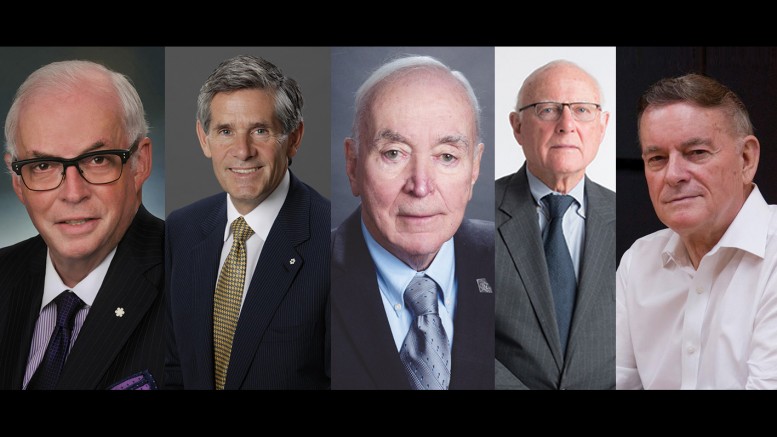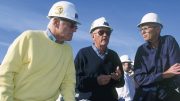In 2017 the Canadian Mining Hall of Fame will welcome five new inductees: James E. C. Carter, Robert R. McEwen, Donald A. McLeod, William Stearns (Steve) Vaughan and John Zigarlick, Jr. The twenty-ninth annual induction dinner is set for the evening of Jan. 12, 2017, at the Metro Toronto Convention Centre in downtown Toronto.
The Northern Miner is a co-founding sponsor of the Hall of Fame, along with the Canadian Institute of Mining, Metallurgy and Petroleum, the Mining Association of Canada and the Prospectors & Developers Association of Canada. For more information and tickets to the event, please visit www.mininghalloffame.ca.

James E. C. Carter
James E. C. Carter
(b. 1950)
James Carter is a giant in the history of Canada’s oilsands and an exemplary leader in their sustainable development. He transformed the fledgling industry — and the frontier town of Fort McMurray, Alta. — into a powerful economic engine for the nation while building Syncrude Canada into one of the world’s largest and most successful energy producers. During his 28-year career with Syncrude, Carter revolutionized the oilsands industry through bold innovation. He championed development of the world’s largest trucks and shovels and introduced hydro-transport of oilsands and other leading-edge technologies that cost-effectively improved the industry’s performance. He was a pioneering advocate of Aboriginal hiring and business development, and contributed to the creation of a guidance tool for corporate social responsibility (CSR) launched by the Mining Association of Canada (MAC). His commitment to research and education is best exemplified by his pivotal efforts to preserve and build the University of Alberta’s Mining Engineering program.
Born in Glasgow, Scotland, Carter emigrated to Canada with his family in 1959, settling in Prince Edward Island. He obtained a Bachelor’s degree in mining engineering from the Nova Scotia Technical College in 1973. He joined Syncrude in 1979 and became vice-president of operations a decade later, after completing a management program at the Harvard Graduate School of Business. He recognized the need for economies of scale in the oilsands early in his career and made the controversial decision to switch to 170-ton trucks from those half that capacity. He later worked with suppliers to develop the world’s largest shovels and the world’s largest 400-tonne capacity trucks.
He also introduced the first patented hydro-transport of oilsands, which rendered conveyor belts obsolete and allowed satellite operations to be linked to distant extraction facilities. This breakthrough combined with the use of large-scale mining equipment reduced the energy required to produce a barrel of bitumen by 40%, with economic and environmental benefits. During his term as president from 1997 to 2007, Syncrude’s production rose from approximately 200,000 barrels to 350,000 barrels per day, while its market capitalization grew from $3 billion to approximately $45 billion.
Carter was a proactive and respected advocate of responsible development. During his tenure, Syncrude became the single largest employer of Aboriginal people, and 20 years later, more than 200 Aboriginal-owned companies conduct an estimated $1-billion of annual business with the industry. As a board member and later chair of MAC, he was a driving force behind the creation and implementation of the Towards Sustainable Mining program, now at the cutting edge of CSR practice in Canada and globally.
In the early 1990s, Carter marshalled industry leaders to rescue the struggling University of Alberta’s Mining Engineering program and build it into the successful institution it is today. He also helped launch an innovative apprenticeship program for skilled trades that has helped thousands of young people launch their careers.
Carter has received many awards for his achievements, including three honorary doctorates, the Queen’s Diamond Jubilee Medal in 2012, and the Order of Canada in 2014.

Robert R. McEwen
Robert R. McEwen
(b. 1950)
Robert (Rob) McEwen is one of Canada’s most innovative, original and dynamic mining entrepreneurs. He is best known for transforming Goldcorp Inc. from a holding company into a global gold-mining powerhouse and revitalizing Ontario’s Red Lake gold mine through the discovery of new high-grade resources at depth. His famous “Goldcorp Challenge” in 2000, which provided open access to 50 years of proprietary geological data from Red Lake and offered prizes to anyone who could find the next six million ounces of gold, created an estimated $6 billion of value from subsequent discoveries. McEwen is also an astute investor and corporate strategist, as demonstrated by Goldcorp’s friendly merger with Wheaton River Minerals in 2005. Goldcorp shares tripled in the next 14 months as it grew through a series of mergers into one of the world’s largest gold producers. He went on to build a new flagship, McEwen Mining, while supporting many worthy causes through donations totalling more than $50 million to date.
Born and raised in Toronto, McEwen worked at his father’s investment firm after earning a B.A. from the University of Western Ontario in 1973, followed by an MBA from York University in 1978. In the 1980s, he took the reins of Goldcorp, then a gold fund, and managed its investment portfolio.
In 1989, he led Goldcorp’s acquisition of Dickinson Mines and its aging and capital-starved gold mine in the famous Red Lake camp, and began building an operating company. His faith in the mine’s untapped potential was rewarded after a $10-million exploration program led to a high-grade discovery in the mid-1990s. In a brilliant move, he created the “Goldcorp Challenge” and placed the mine’s geological data since 1948 on the internet and offered $575,000 in prizes for the best exploration concepts. More than 1,000 participants from 80 countries took part, resulting in more than 50 new targets, 80% of which yielded total gold resources valued at $6 billion. The Red Lake mine was transformed from a 50,000-ounce producer in 1997 to a 500,000-ounce producer in 2001, while cash costs fell from $360 per ounce to $60 per ounce over this period.
Goldcorp went on to become a star performer, with its share price appreciating at a compound annual rate of 31% between 1993 and 2004. McEwen stepped down from Goldcorp after its high-profile $2.4-billion merger with Wheaton River to focus on junior mining. After acquiring U.S. Gold and expanding its assets, he merged the junior with Minera Andes to create McEwen Mining, a gold, silver and copper producer with projects in Nevada, Mexico and Argentina.
As a philanthropist, McEwen has donated more than $50 million to encourage excellence, innovation and leadership in healthcare and education. He also contributed to the Red Lake Margaret Cochenour Memorial Hospital, the Red Lake Regional Heritage Centre, St. Andrews College Leadership Program, Rumie Initiative and most recently the McEwen School of Architecture at Laurentian University. In addition to an honorary degree from York University, McEwen has received many accolades for his achievements, including Developer of the Year for 2001, Mining Man of the Year for 2002, Most Innovative CEO in 2006, and the Order of Canada in 2007.

Donald A. McLeod
Donald A. McLeod
(b. 1928)
Donald McLeod is a revered and iconic figure in Canada’s mining industry and an inspirational role model for young mining entrepreneurs. Born and raised in Stewart, B.C., he began his career as a pack-horse operator and miner’s helper in the 1940s, and went on to become a successful mine finder, developer, and founder of the Vancouver-based Northair Group of Companies. He is best known for developing the Brandywine and Summit gold mines in BC, and for making high-grade gold discoveries at the Brucejack project. He also mentored and encouraged countless people to pursue opportunities in the mining industry, including his daughter Catherine and son Bruce, who both achieved success in their own rights.
McLeod’s life journey was shaped his Scottish roots and the mining heritage of his home town. Starting as a teen-ager, McLeod learned almost every aspect of the business as he rose through the ranks at various mines. After managing the discovery of a rich lead-zinc deposit at Pine Point, N.W.T., he was inspired to move his young family to Vancouver and start his own mining company.
In 1972, as president of Northair Mines, he optioned a grassroots discovery near Whistler, B.C., and brought it into production 42 months later. It was an astounding feat, accomplished in a politically challenging era through stubborn persistence and his infectious optimism. Over the next seven years, the Brandywine mine profitably produced more than $70 million worth of gold, silver, lead and zinc.
McLeod also developed the Summit gold mine and raised more than $200 million of equity for his Northair Group of Companies before retiring in 2014.
In the 1980s, one of his companies, Newhawk Gold Mines, discovered high-grade gold deposits at the Brucejack project in the “Golden Triangle” region north of Stewart. Brucejack was ultimately acquired by Pretium Resources, which went on to discover the 6.9-million-ounce Valley of the Kings gold deposit slated for commercial production in 2017.
McLeod exemplifies the qualities that have made Canada a leader in the global mining industry. His willingness to take on projects in difficult terrains and climates — often under challenging political or market conditions — is a testament of his tenacity and pioneering “can-do” spirit. His demonstrated integrity and professionalism throughout his 70 years in mining has earned him the trust of his peers, employees and shareholders.
He was intimately familiar with every aspect of the industry from the bush to the boardroom and these experiences gave him the credibility and the sensitivity to encourage others to follow their dreams in the “equal opportunity” mining industry.
McLeod has generously supported health and education causes, including the Mining for Miracles campaign, and St. Paul’s Hospital Foundation through the creation of the McLeod Family Professorship in Valvular Heart Disease Intervention. In addition to being named a “Mining Living Legend” by Cambridge House, McLeod was the recipient of AME BC’s E.A. Scholz Award for excellence in mine development, and the CIM’s Proficiency Award.

William Stearns (Steve) Vaughan
William Stearns
(Steve) Vaughan
(b. 1937)
William (Steve) Vaughan helped elevate the stature of Canada’s mining industry at home and abroad as a leading expert and advisor on natural resource law, project finance and mineral policy matters for more than 40 years. With a rare background in both geology and law, he served as head of the mining practice for a number of Toronto-based law firms and earned his peer-ranked status as one of best mining lawyers in Canada and the world. His expertise has benefited countless clients involved in resource development in more than 65 countries and strengthened the legal administration of the global minerals industry. Vaughan is also known as a trailblazing advocate of corporate social responsibility and a dedicated industry advocate. He was involved in numerous initiatives to improve mining and investment policies in Canada, and promote industry best practices. In the aftermath of the 1997 Bre-X Minerals fraud, he was a driving force behind the OSC/TSX Mining Standards Task Force, which called for new mining disclosure standards, later adopted as National Instrument 43-101. He actively supported the successful globalization of the Canadian mining industry and helped numerous foreign jurisdictions lay the foundation for progressive mining policies and fiscal regimes. As the “Elder Dean” of the Canadian mining legal fraternity, he was an exemplary mentor to dozens of young mining lawyers in Canada and other mining nations.
Born in Fredericton, N.B., Vaughan earned a B.Sc. degree in geology from the University of New Brunswick (UNB) in 1959, followed by a M.Sc. degree from McGill University in 1962 and an LLD (honoris causa) from UNB in 2015. After completing his law degree at UNB in 1965, he joined Aird & Berlis and became head of its Toronto-based mining group. His client list expanded in the 1990s as companies faced regulatory roadblocks, permitting challenges and stakeholder opposition to foreign and domestic projects. In the early ‘90s, he participated in the multi-stakeholder Whitehorse Mining Initiative and its efforts to seek consensus-based support for responsible mineral development in Canada. The rapport he developed with government official and other stakeholders subsequently led to policy reforms and broad acceptance and advancement of mining’s role as an economic engine in Canada and the developing world.
Vaughan drafted the first flow-through share mining prospectus financing in Canada. Vaughan also played a leadership role as the only local member of the Mining Standards Task Force Committee established by the OSC and the TSX to restore investor confidence after the Bre-X scandal. Many of the committee’s recommendations, including stronger disclosure standards for mineral projects and the involvement of a Qualified Person, were incorporated into National Instrument 43-101 and adopted in 2001.
Vaughan has been a director of the Prospectors and Developers Association of Canada (PDAC) for more than 35 years, and strongly supported its successful transition from a domestic-focused entity into a leading international mining association. He helped organize gatherings of the world’s mine ministers and shared his expertise through published papers and lectures while serving as a distinguished ambassador of Canada’s mining industry. He was also an inspirational mentor to a new generation of mining lawyers in Canada, Chile, Peru, Argentina, Mongolia, China, South Korea and many other mining nations.
Vaughan was the recipient of PDAC’s Distinguished Service Award in 2002 and was named a Distinguished Lecturer by the Canadian Institute of Mining and Metallurgy for 2002/2003.

John Zigarlick, Jr.
John Zigarlick, Jr.
(1937-2011)
John Zigarlick, Jr. was a visionary mine-maker and company-builder who left an enduring legacy in Canada’s North through innovative infrastructure development and the formation of progressive Aboriginal business partnerships. As head of Echo Bay Mines in the 1980s, Zigarlick conceived and led construction of the world’s largest winter road in order to service the Lupin gold mine, which he built using air support due to its remote location 400 km northeast of Yellowknife. The Tibbitt to Contwoyto road was a daunting challenge, as 75% of the 568-km route was built over lake ice, making it the largest ice road of that time. Under Zigarlick’s leadership, Lupin became one of Canada’s top gold producers while Echo Bay grew from a net worth of $7 million in 1979 into a North American producer with a 1992 market capitalization of approximately $2 billion.
After retiring from Echo Bay, Zigarlick incorporated Nuna Logistics as a partnership with the Inuit of the Kitikmeot Region in Nunavut. It was a timely move, as the ice road he helped create provided a lifeline for Canada’s first diamond mines and a host of other projects. Nuna became the largest Aboriginal civil contractor in Canada, and provided a role model for similar ventures.
Born in Winnipeg, Zigarlick followed in his father’s footsteps and worked in uranium mining camps of northern Saskatchewan before leaving to serve in Canadian military. In 1971, he joined Echo Bay as a purchasing and personnel manager and became president and CEO in 1977, after earning a degree in business administration from the Northern Alberta Institute of Technology. Echo Bay’s sole asset was the Port Radium silver mine in the N.W.T., which was supplied by air and a winter road from the Mackenzie Highway, several hundred kilometres to the south.
As Port Radium neared depletion, Zigarlick acquired the remote Lupin gold discovery and after a brief underground program, proposed a mine. It was not an easy sell to Echo Bay’s owners, but Zigarlick persevered and built Lupin almost entirely with materials brought in by Hercules and Convair aircraft, on time and on budget, in 1982. He then took on the challenge of building a winter road to service Lupin, a phenomenal feat that contributed to the mine’s profitability and demonstrated the viability of remote Arctic mines to the world. Echo Bay went on to acquire and develop additional mines in Nevada, Colorado and Washington state.
In 1993, Zigarlick formed Nuna Logistics with two Inuit corporations and took over annual construction of his old Lupin winter road, which fortuitously passed near diamond discoveries being developed into the Ekati and Diavik mines. The road went from handling 500-600 truck loads per year while serving Lupin to more than 10,000 truck loads annually while serving the diamond mines at their peak.
Zigarlick also found time for charitable work, particularly with the Boyle Street Soup Kitchen in Edmonton, where he served Christmas dinner for sixteen years. His legacy lives on through his famous winter road and the success of the Aboriginal businesses he helped foster. He was the recipient of numerous awards, including the CIM’s John Campbell Sproule Award, The Northern Miner’s 1984 Mining Man of the Year, PDAC’s 1985 Distinguished Service Award, and the 2006 Transport Association of Canada Award.






Be the first to comment on "Five industry standouts to join Canadian Mining Hall of Fame"